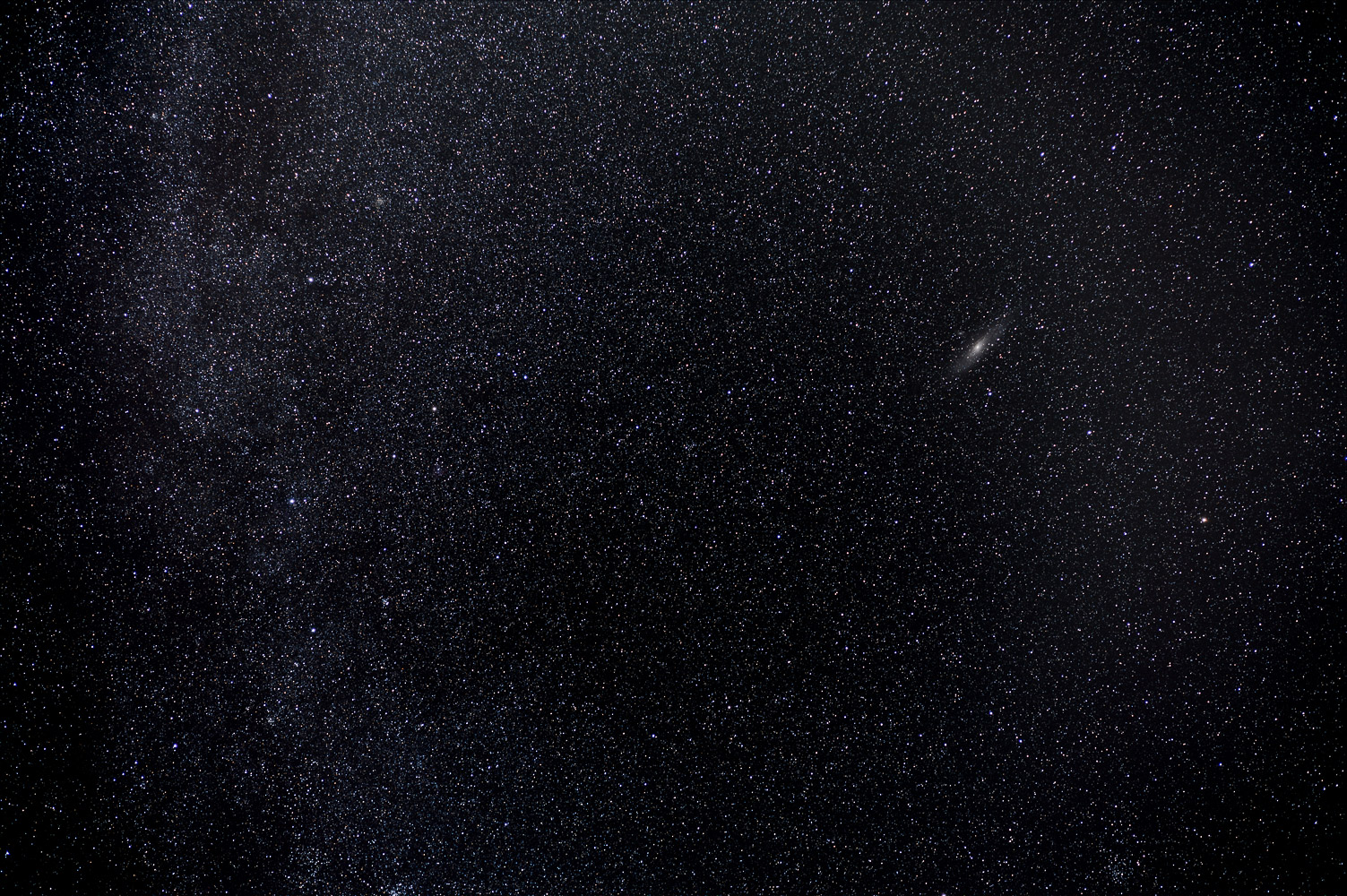|
Here's my third serious attempt at Astrophotography. OK, I'll stop numbering them now. This one shows Cassiopeia, the small-ish W in the northern sky, and the central part of Andromeda, which includes the galaxy M31. North is to the left. The image formed from 40 exposures of 30 seconds each is shown below. Cassiopeia is one of my favorite constellations because it's the constellation I observed from my Madison Heights back yard on the first night I used my 8-inch telescope in October of 1984. As this was all new to me at that time, I was pretty unsure about the precise spots in the sky where the objects were located, and unsure of what I should expect them to look like, so I spent the first month or two with that telescope concentrating on this constellation, reviewing it again and again until my confidence in what I was seeing grew. The marked-up copy of this photo is shown below. The W of Cassiopeia is drawn-in as lines, and there are 7 circled objects, which we'll address from top to bottom. The top-most object is the open cluster NGC 7789, a compressed grouping of about 100 pretty-faint stars in a 1/4 degree area (about 1/4 the area of the full moon). That's actually a large number of stars for an open cluster; they're often composed of perhaps 20 to 50 stars, so this cluster is considered pretty rich, in astro-talk. I first tried for this cluster in December of 1984 (I guess I was still stuck in Cassiopeia at that point) but had the wrong spot. I first saw the cluster in August of 1985, and drew the sketch below during October of 1991 from the darker skies of my house in Shelby Township. Since north is to the left in the photo, the sketch needs to be turned counter-clockwise 90-degrees to match up to the stars. I don't know when or why I wrote "poor sketch" on this sketch :-) Moving over to the right side of the photo, the next object from the top is the Great Andromeda Galaxy, or M31. Earlier during this night, and a couple nights ago, I took photos specifically of this galaxy using a higher-magnification lens. The one from a couple days ago turned out the best, so I'll just refer to that blog posting for my best shot of M31 and its description. But below is the not-too-shabby enlargement of M31 in this photo of Cassiopeia and Andromeda. The third circle from the top surrounds the gaseous nebula NGC 281, prosaicly known as the PacMan Nebula. This is a region of star formation, where the interstellar gas supply has condensed enough to ignite stars, and the light from those stars makes the remaining gas glow pinkish-red. It barely registers on this photograph. Visually, I couldn't see this at all from Madison Heights, I could barely see a glow from Shelby Township (probably similar to this photograph), and during 2005 from Casco Township I could make out the nebula relatively easily. It's about a 25-arcminute glow, with a pie-wedge bite taken out of it, resulting in the PacMan name. I also noted it to be shaped like a comma rather than a PacMan. Fourth from the top is the easy-to-find-and-see open cluster NGC 457, which I always thought was shaped like an arrowhead. This one has several bright stars which make it stand out even from Madison Heights in November of 1984, and about 75 much fainter stars which make it more impressive from the darker skies of Shelby Township in September of 1990. This photograph appears to show mainly the brighter stars, so perhaps the fainter ones are beyond the limits of 40 30-second exposures (20 minutes total). I sketched it from Shelby Township in October of 1991, shown in the second photo below (again rotate it 90 degrees to match the photo) Fifth from the top is Messier 103 (M103), which I remember looking for without luck on that first night with my 8-inch telescope. I think I was expecting something brighter, larger, and splashier, so I probably rejected the actual cluster out-of-hand. But by November and December of 1984 I was confident I'd found the cluster, and I sketched it in September of 1989 from Shelby Township. The central (brightest) star of the cluster is a red giant, and a dipper-shaped grouping of stars is in the same telescopic field of view. I counted 40 stars in this cluster from Casco Township in October of 2005. Sixth from the top is the open cluster NGC 663, one of the objects I saw on my first night with my 8-inch scope in Madison Heights. I couldn't identify it with anything on my charts, but I thought it was a bright splashy group so wrote it down in my notes. Over the next couple of months I identified it as NGC 663. It's a football-shaped group of about 30 stars with 3 double-stars within it. I sketched it from Shelby Township in September of 1989. Seventh from the top is the open cluster NGC 752. Apparently by November of 1984 I'd ventured beyond Cassiopeia and found this very large and obvious cluster of 75 stars. My sketch from Shelby Township in October of 1991 labels the orange, blue and red stars near the center of the cluster. In August of 1995 I was able to see a glow in this area with a few resolved stars with 7x50 binoculars from the Porcupine Mountain State Park of the Upper Peninsula of Michigan. |
